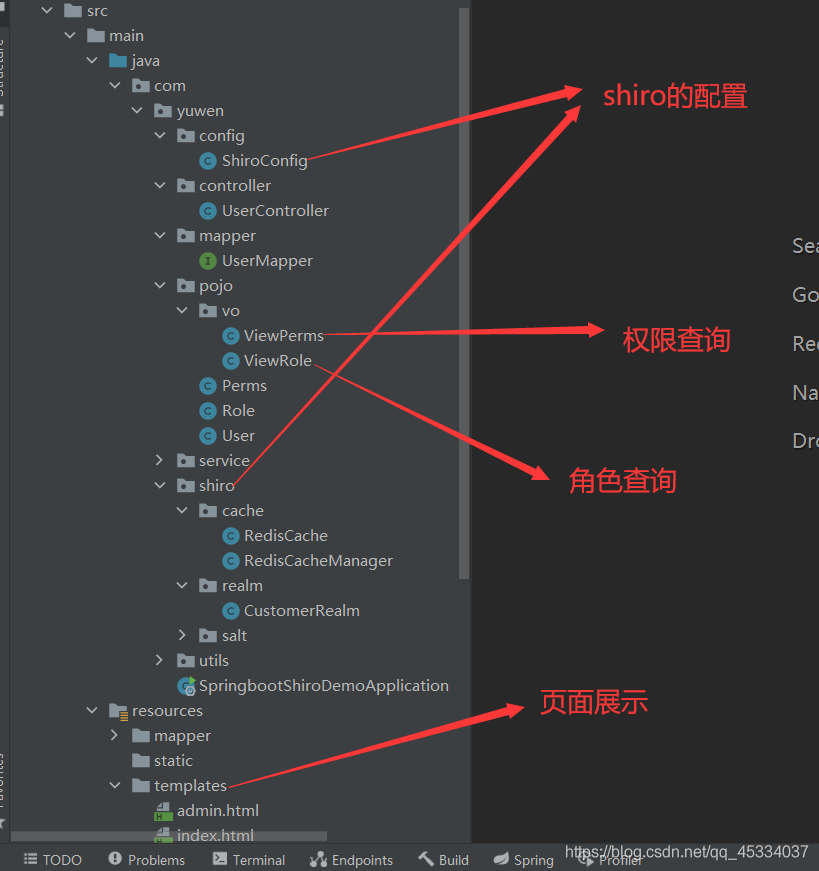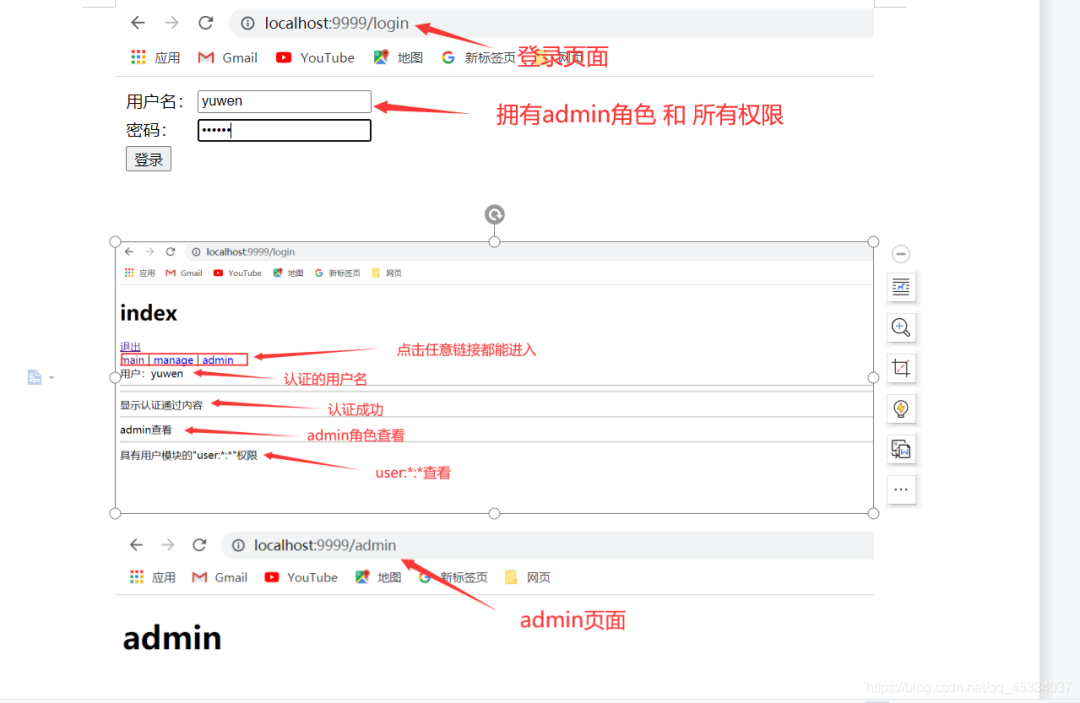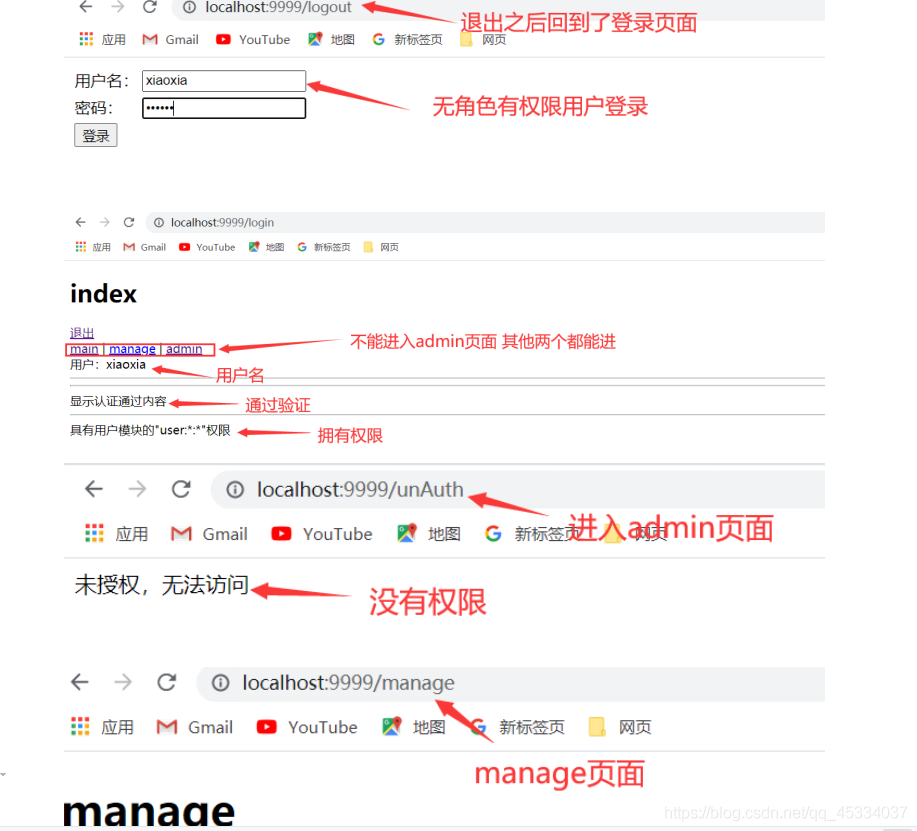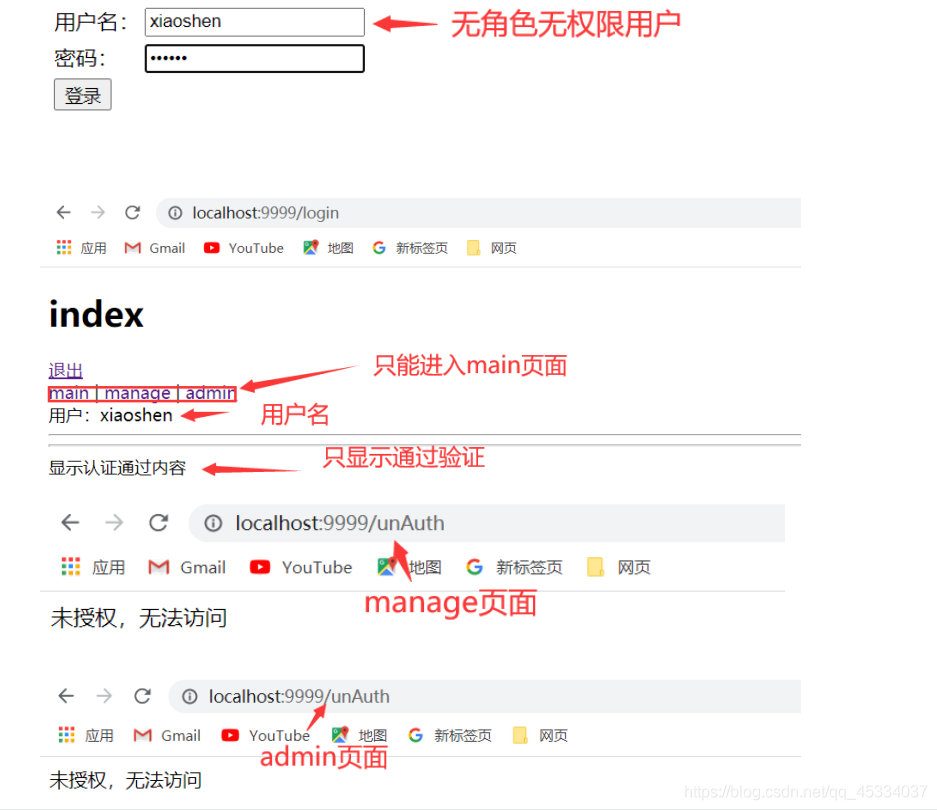SpringBoot整合Shiro实现权限控制
点击上方蓝色字体,选择“标星公众号”
优质文章,第一时间送达
1、SpringBoot整合Shiro
Apache Shiro是一个强大且易用的Java安全框架,执行身份验证、授权、密码和会话管理。
1.1、shiro简介
shiro有个核心组件,分别为Subject、SecurityManager和Realms
Subject:相当于当前操作的”用户“,这个用户不一定是一个具体的人,是一个抽象的概念,表明的是和当前程序进行交互的任何东西,例如爬虫、脚本、等等。所有的Subject都绑定到SecurityManager上,与 Subject 的所有交互都会委托给 SecurityManager;可以把 Subject 认为是一个门面;SecurityManager 才是实际的执行者。
SecurityManager:这个是shiro框架的核心,所有与安全相关的操作都会与它进行交互,它管理者所有的Subject。
Realms:充当了Shiro与应用安全数据间的”桥梁“,当对用户执行认证(登录)和授权(访问控制)验证时,SecurityManager 需要从 Realm 获取相应的用户进行比较以确定用户身份是否合法;也需要从 Realm 得到用户相应的角色 / 权限进行验证用户是否能进行操作。
如果想要更加深入的了解的shrio可以参考:https://www.w3cschool.cn/shiro/co4m1if2.html
1.2、代码的具体实现
1.2.1、Maven的配置
<!--shiro-->
<dependency>
<groupId>org.apache.shiro</groupId>
<artifactId>shiro-spring-boot-starter</artifactId>
<version>1.7.1</version>
</dependency>
<!--shiro整合thymeleaf-->
<dependency>
<groupId>com.github.theborakompanioni</groupId>
<artifactId>thymeleaf-extras-shiro</artifactId>
<version>2.0.0</version>
</dependency>
<!--shiro缓存-->
<dependency>
<groupId>org.apache.shiro</groupId>
<artifactId>shiro-ehcache</artifactId>
<version>1.7.1</version>
</dependency>
shiro默认是与jsp进行使用的,而这里是shiro整合thymeleaf所有要导入shiro整合thymeleaf的jar包
1.2.2、整合需要实现的类
一般来说整合只需要完成两个类的实现即可
一个是 ShiroConfig 一个是 CustomerRealm
如果需要添加shiro缓存并且不是自带的缓存而是redis缓存还需要进行另外两个类的编写
一个是 RedisCache 一个是 RedisCacheManager
1.2.3、项目结构

1.2.4、ShiroConfig的实现
未加shiro的缓存
package com.yuwen.config;
import at.pollux.thymeleaf.shiro.dialect.ShiroDialect;
import com.yuwen.shiro.cache.RedisCacheManager;
import com.yuwen.shiro.realm.CustomerRealm;
import org.apache.shiro.authc.credential.HashedCredentialsMatcher;
import org.apache.shiro.realm.Realm;
import org.apache.shiro.spring.web.ShiroFilterFactoryBean;
import org.apache.shiro.web.mgt.DefaultWebSecurityManager;
import org.springframework.beans.factory.annotation.Qualifier;
import org.springframework.context.annotation.Bean;
import org.springframework.context.annotation.Configuration;
import java.util.HashMap;
import java.util.Map;
@Configuration
public class ShiroConfig {
//让页面shiro标签生效
@Bean
public ShiroDialect shiroDialect(){
return new ShiroDialect();
}
//1、创建shiroFilter 负责拦截所有请求
@Bean
public ShiroFilterFactoryBean shiroFilterFactoryBean(DefaultWebSecurityManager defaultWebSecurityManager){
ShiroFilterFactoryBean factoryBean = new ShiroFilterFactoryBean();
//给filter设置安全管理
factoryBean.setSecurityManager(defaultWebSecurityManager);
//配置系统的受限资源
//配置系统公共资源 全部都能访问的设置anon
Map<String,String> map = new HashMap<>();
map.put("/main","authc");//请求这个资源需要认证和授权 authc表示需要认证后才能访问
map.put("/admin","roles[admin]"); //表示admin角色才能访问 roles[]表示需要什么角色才能访问
map.put("/manage","perms[user:*:*]"); //表示需要user:*:*权限才能访问 perms[]表示需要什么权限才能访问
//访问需要认证的页面如果未登录会跳转到/login路由进行登陆
factoryBean.setLoginUrl("/login");
//访问未授权页面会自动跳转到/unAuth路由
factoryBean.setUnauthorizedUrl("/unAuth");
factoryBean.setFilterChainDefinitionMap(map);
return factoryBean;
}
//2、创建安全管理器
@Bean
public DefaultWebSecurityManager defaultWebSecurityManager(@Qualifier("getRealm") Realm realm){
DefaultWebSecurityManager securityManager = new DefaultWebSecurityManager();
//给安全管理器设置
securityManager.setRealm(realm);
return securityManager;
}
//3、创建自定义的realm
@Bean
public Realm getRealm(){
CustomerRealm customerRealm = new CustomerRealm();
//修改凭证校验匹配器
HashedCredentialsMatcher credentialsMatcher = new HashedCredentialsMatcher();
//设置加密算法为md5
credentialsMatcher.setHashAlgorithmName("MD5");
//设置散列次数
credentialsMatcher.setHashIterations(1024);
customerRealm.setCredentialsMatcher(credentialsMatcher);
return customerRealm;
}
}
因为一般在数据库中设置明文密码不安全,所有我这里对密码进行了md5加密,我的加密方式为:密码 = 密码+盐+散列次数 而后进行MD5加密 所以这里创建自定义的realm时需要进行设置匹配器这样登录时密码才能匹配成功
1.2.5、CustomerRealm的实现
package com.yuwen.shiro.realm;
import com.yuwen.pojo.User;
import com.yuwen.pojo.vo.ViewPerms;
import com.yuwen.pojo.vo.ViewRole;
import com.yuwen.service.UserService;
import com.yuwen.shiro.salt.MyByteSource;
import org.apache.shiro.authc.AuthenticationException;
import org.apache.shiro.authc.AuthenticationInfo;
import org.apache.shiro.authc.AuthenticationToken;
import org.apache.shiro.authc.SimpleAuthenticationInfo;
import org.apache.shiro.authz.AuthorizationInfo;
import org.apache.shiro.authz.SimpleAuthorizationInfo;
import org.apache.shiro.realm.AuthorizingRealm;
import org.apache.shiro.subject.PrincipalCollection;
import org.apache.shiro.util.CollectionUtils;
import org.springframework.util.ObjectUtils;
import javax.annotation.Resource;
import java.util.List;
//自定义realm
public class CustomerRealm extends AuthorizingRealm {
@Resource
private UserService userService;
//授权
@Override
protected AuthorizationInfo doGetAuthorizationInfo(PrincipalCollection principalCollection) {
//获取身份信息
String primaryPrincipal = (String)principalCollection.getPrimaryPrincipal();
//根据主身份信息获取角色 和 权限信息
List<ViewRole> roles = userService.findRolesByUsername(primaryPrincipal);
if (!CollectionUtils.isEmpty(roles)){
SimpleAuthorizationInfo simpleAuthorizationInfo = new SimpleAuthorizationInfo();
roles.forEach(viewRole -> {
simpleAuthorizationInfo.addRole(viewRole.getName());
//权限信息
List<ViewPerms> perms = userService.findPermsByRoleId(viewRole.getName());
if (!CollectionUtils.isEmpty(perms)){
perms.forEach(viewPerms -> {
simpleAuthorizationInfo.addStringPermission(viewPerms.getPName());
});
}
});
return simpleAuthorizationInfo;
}
return null;
}
//认证
@Override
protected AuthenticationInfo doGetAuthenticationInfo(AuthenticationToken authenticationToken) throws AuthenticationException {
//获取登入的身份信息
String principal = (String) authenticationToken.getPrincipal();
User user = userService.findByUsername(principal);
if (!ObjectUtils.isEmpty(user)){
//ByteSource.Util.bytes(user.getSalt()) 通过这个工具将盐传入
//如果身份认证验证成功,返回一个AuthenticationInfo实现;
return new SimpleAuthenticationInfo(user.getUsername(),user.getPassword(),new MyByteSource(user.getSalt()),this.getName());
}
return null;
}
}
在登录时会自动调用这个身份验证 在验证时如果出错,会报异常,我在controller层接收了异常并处理
controller层中登录时的异常处理
@PostMapping("/login")
public String login(String username,String password){
//获取主体对象
Subject subject = SecurityUtils.getSubject();
try {
//自动调用CustomerRealm 类中的身份验证方法
subject.login(new UsernamePasswordToken(username,password));
return "index";
}catch (UnknownAccountException e){ //接收异常并处理
e.printStackTrace();
model.addAttribute("msg","用户名有误,请重新登录");
}catch (IncorrectCredentialsException e){//接收异常并处理
e.printStackTrace();
model.addAttribute("msg","密码有误,请重新登录");
}
return "login";
}
1.2.6、shiro缓存配置
定义了shiro缓存,用户登录后,其用户信息、拥有的角色 / 权限不必每次去查,这样可以提高效率
默认缓存的配置
在 ShiroConfig中 的 getRealm() 方法中开启缓存管理
@Bean
public Realm getRealm(){
CustomerRealm customerRealm = new CustomerRealm();
//开启缓存管理
customerRealm.setCacheManager(new EhCacheManager());
//开启全局缓存
customerRealm.setCachingEnabled(true);
//开启认证缓存
customerRealm.setAuthenticationCachingEnabled(true);
customerRealm.setAuthenticationCacheName("authenticationCache");
//开启权限缓存
customerRealm.setAuthorizationCachingEnabled(true);
customerRealm.setAuthorizationCacheName("authorizationCache");
return customerRealm;
}
与reids整合的缓存这里就不说明了,放在源码里自己查看,源码在下方
1.2.7、主页index.html的设置
在这里用标签来判断某些区域需要认证或什么角色或者什么权限才能访问
<!DOCTYPE html>
<html lang="en" xmlns="http://www.w3.org/1999/xhtml" xmlns:th="http://www.thymeleaf.org"
xmlns:shiro="http://www.pollix.at/thymeleaf/shiro">
<head>
<meta charset="UTF-8">
<title>首页</title>
<link rel="shortcut icon" href="#">
</head>
<body>
<h1>index</h1>
<a href="/logout">退出</a>
<div>
<a href="/main">main</a> | <a href="/manage">manage</a> | <a href="/admin">admin</a>
</div>
<!--获取认证信息-->
用户:<span shiro:principal=""></span><hr>
<!--认证处理-->
<span shiro:authenticated=""><hr>
显示认证通过内容
</span>
<span shiro:notAuthenticated=""><hr>
没有认证时 显示
</span>
<!--授权角色-->
<span shiro:hasRole="admin"><hr>
admin角色 显示
</span>
<span shiro:hasPermission="user:*:*"><hr>
具有用户模块的"user:*:*"权限 显示
</span>
</body>
</html>
1.3、简单测试

1.3.1、admin角色所有权限测试

1.3.2、无角色有权限测试

1.3.3、无角色无权限测试


1.4 项目源码
需要源码的在这:https://gitee.com/residual-temperature/shiro-demo
作者 | yuwenS
来源 | cnblogs.com/yuwenS/p/15045474.html

